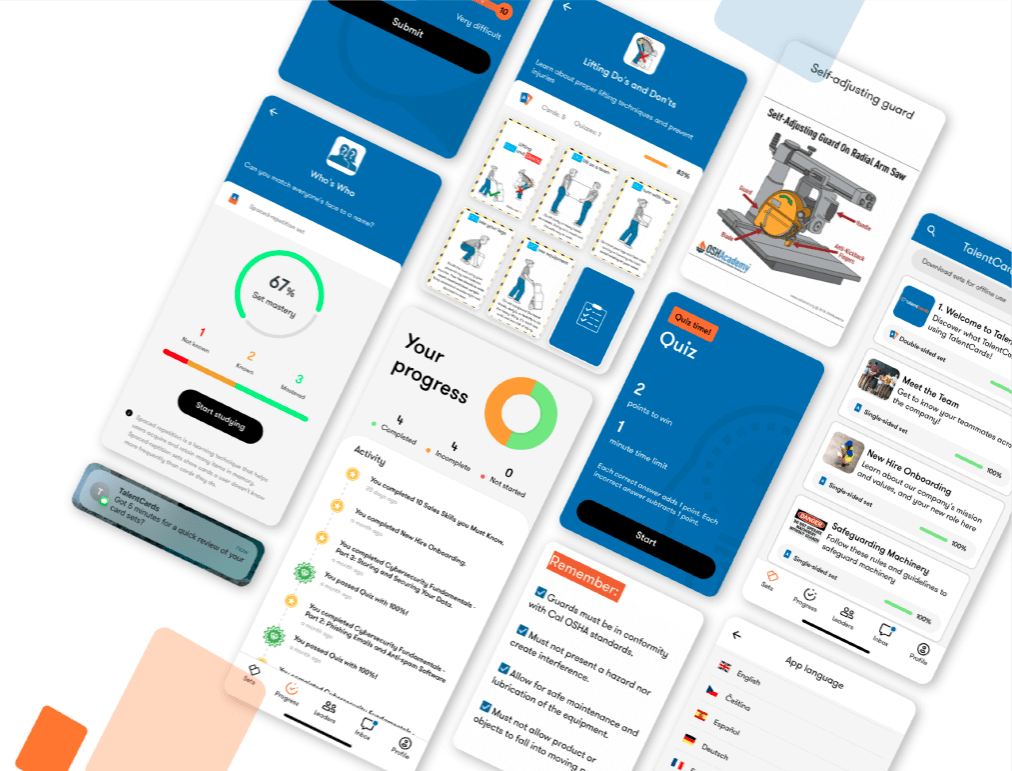In today’s ever-changing professional world, the focus is increasingly on the unique qualities that each employee brings to the table. Understanding and utilizing employee strengths isn’t just a passing trend. It’s a must for creating a thriving and productive workplace.
Employee strengths go beyond mere buzzwords; they form the foundation of a resilient, innovative, and collaborative workforce. Recognizing and nurturing these strengths doesn’t only benefit the individual employee; it has a ripple effect throughout the entire organization, influencing productivity, job satisfaction, and overall success.
Research from Gallup indicates that when employees discover and embrace their strengths, productivity is substantially boosted. Specifically, individuals who understand their strengths become 7.8% more productive.
Moreover, teams that prioritize strengths daily experience an even more significant impact, with a remarkable 12.5% increase in overall productivity.
If you’re ready to identify and learn how to grow employee strengths, follow along as we lay out exactly what you need to know. It’s time to amplify your greatest asset— your people.
What are employee strengths?
Everyone brings something special to the table at work – unique skills, abilities, and qualities known as employee strengths.
These strengths vary from person to person, ranging from excellent communication skills to a talent for solving problems.
Employee strengths aren’t something people are born with or without. While some may develop certain strengths more easily than others, anyone can develop strengths. Often, employee strengths are confused with personality traits, but it’s important to remember that the two are different. One is a part of who you are. The other is something you can learn and develop over time.
Knowing that strengths are skills that are learned and made better over time, you can move on to leveraging them. When a company acknowledges and uses these strengths, it can create a team with varying abilities, making it more capable of facing challenges and adapting to changes.
Key strengths of an employee
Employee strengths embody distinct qualities and attributes that individuals bring to their roles. These go beyond mere skills listed on a resume. They’re the inherent traits that shape how employees:
- Tackle challenges
- Work collaboratively
- Contribute to the overall success of the organization
Leadership skills motivate a team, problem-solve to navigate tricky situations, and effective communication that allows seamless collaboration. An employee’s strengths come to life in adaptability, time management, creativity, and emotional intelligence.
These strengths aren’t one-size-fits-all. They’re a diverse spectrum, showcasing the richness each individual brings to the workplace.
Employee strengths pulse through a thriving workplace, surpassing job description tasks. They shape collaboration, innovation, and overall success.
Recognizing and leveraging these strengths maximizes your workforce potential, creating an environment where your employees feel valued and motivated. Understanding and appreciating these strengths form the foundation for a workplace that surpasses goals, powered by the collective strength of each individual’s unique contributions.
How to identify employee strengths and weaknesses
Unlocking a person’s professional potential involves a strategic understanding of strengths and development areas. Training managers and HR professionals must guide employees in this self-discovery journey. Here’s how to help your staff pinpoint their strengths and areas for improvement:
1. Explore personal preferences
Encourage employees to reflect on their work preferences. What tasks ignite their motivation? What responsibilities do they tend to postpone? Ask questions like:
- What motivates you?
- What tasks do you procrastinate on?
- Which work accomplishments make you most proud?
- Why do colleagues seek your assistance or advice?
2. Revisit role responsibilities
Remind employees that their skill set aligns with the expectations set during the hiring process. Request the job posting from the recruitment team to revisit the skills, competencies, and attributes sought. Additionally, consider strengths highlighted during interviews, onboarding, or performance reviews.
3. Feedback and evaluation
Feedback and evaluation are key to identifying and nurturing employee strengths. Performance reviews, feedback sessions, and 360-degree evaluations offer a platform for discussing strengths, areas of improvement, and professional goals. This ongoing dialogue helps employees recognize their strengths and ensures managers can effectively leverage them.
4. Identify and review patterns
Encourage employees to review collected insights for patterns. Some strengths and weaknesses stand out distinctly. For instance, if negotiating contracts is a consistent accomplishment, it likely involves strong active listening, problem-solving, and communication skills. Alternatively, struggles with deadlines may point to weaknesses in time management.
Improving and leveraging strengths
After identifying strengths and areas for improvement, the journey of self-improvement begins. As a training manager or HR professional, guide employees to:
- Create a list of areas for improvement.
- Set SMART goals (Specific, Measurable, Attainable, Relevant, Timely).
- Focus on refining weak areas and building on strengths.
- Encourage facing fears, such as public speaking, by seeking opportunities to practice.
- Provide professional development resources, training reinforcement, coaching, upskilling initiatives, or certification programs from the HR department.
- Acknowledging weaknesses with a growth mindset sets individuals apart and fosters a culture of continuous improvement within the organization.
Identifying strengths allows for effective task delegation and role alignment, while acknowledging weaknesses opens avenues for growth and development.
Addressing employee weaknesses
Recognizing and addressing employee weaknesses isn’t about finding fault, but cultivating a culture of continuous improvement.
Upon identification, personalized development plans are crafted, involving targeted training, mentorship, or resources for skill enhancement.
A supportive approach, focused on development rather than criticism, encourages employees to see weaknesses as growth opportunities.
What are good examples of strengths for an employee?
Invaluable employee strengths encompass various qualities, from effective communication and adaptability to problem-solving and leadership. These characteristics go beyond job-specific skills, shaping an individual’s approach to collaboration, innovation, and overall contribution to the workplace.
Employee strengths examples
Good strengths for employees include:
- Effective communication
- Adaptability to change
- Problem-solving skills
- Leadership abilities
Recognizing and leveraging these strengths is key to building a robust and productive workforce.
Tailor strengths to the job role
Aligning strengths with the job is crucial for optimal performance. Tailoring these attributes ensures they seamlessly fit the position’s requirements, enhancing the individual’s contribution to the team and organization. This alignment lets employees effectively leverage their strengths within their specific responsibilities.
Build on existing strengths
Continual improvement involves building on existing strengths. Recognizing and capitalizing on these attributes creates a foundation for growth and success.
Employees can enhance their strengths through targeted development plans, training, and mentorship.
20 examples of employee strengths
Employee strengths can present themselves in different ways. Understanding employee strengths allows you to hire smart and build more well-rounded teams.
Here’s an employee strengths list with 20 examples:
- Leadership skills: Inspiring others to achieve common goals.
- Problem-solving abilities: Navigating challenges with creativity.
- Communication skills: Conveying ideas clearly and effectively.
- Adaptability and flexibility: Thriving in dynamic and changing situations.
- Time management: Efficiently organizing and prioritizing tasks.
- Organizational skills: Structuring work for optimal productivity.
- Creativity and innovation: Bringing fresh ideas to the table.
- Critical thinking: Analyzing situations to make informed decisions.
- Empathy and emotional intelligence: Understanding and connecting with others.
- Resilience: Bouncing back from setbacks with determination.
- Decision-making: Making sound and timely decisions.
- Self-motivation: Initiating and completing tasks independently.
- Integrity and honesty: Upholding ethical standards.
- Initiative: Taking proactive steps to achieve goals.
- Dependability and reliability: Consistently delivering high-quality work.
- Attention to detail: Ensuring accuracy in tasks and projects.
- Customer service skills: Building positive relationships with clients.
- Conflict resolution: Navigating and resolving interpersonal conflicts.
- Motivational skills: Inspiring and encouraging team members.
- Goal setting and achievement: Setting and reaching ambitious objectives.
Growing employee strengths
Providing employees with essential tools and resources is vital for their growth. Access to online learning platforms, mentorship programs, and skill-specific workshops empowers individuals to own their development. These resources enhance existing strengths and offer opportunities to explore new ones, fostering a dynamic and adaptable workforce.
Nurture employee strengths with powerful microlearning courses

FAQs
What are staff strengths and weaknesses?
Staff strengths and weaknesses vary from person to person. They can include everything from excellent communication skills to poor time management. Understanding how to identify between the two is important, working through weaknesses and developing and leveraging strengths.
What are good examples of strengths?
Good examples of employee strengths can vary depending on the industry and role. Some common strengths include:
- Communication skills
- Critical thinking
- Problem-solving
- Attention to detail
- Team-orientation
What are the top 3 work related strengths of an employee?
While there are many key strengths of employees, there are three that are most commonly sought after. Those are communication skills, work ethic, and problem-solving.
Unleash the power of employee strengths
Regarding professional growth, understanding and harnessing employee strengths emerge as keystones for success. Training managers and HR professionals go beyond their traditional responsibilities. You are our navigators, guiding individuals toward self-discovery and empowerment.
By identifying strengths, employees can unlock their true potential. Simultaneously, acknowledging weaknesses becomes an opportunity for growth. As facilitators of development, encouraging employees to view weaknesses not as limitations but as opportunities is key. Constructive feedback, revisiting role expectations, and embracing a growth mindset collectively pave the way for a workforce that is continuously evolving and adapting.
Leveraging employee strengths allows individuals to become unique contributors, adding to the collective strength of the organization. It’s not just about nurturing strengths; it’s about unlocking a force that propels individuals and organizations toward unparalleled success.
Key takeaways
- Understanding and leveraging employee strengths is a strategic approach that fuels workplace success. Recognizing individual strengths enhances productivity, job satisfaction, and overall organizational success.
- Employee strengths go beyond resume skills. From leadership to teamwork, each strength enriches the workplace, creating a versatile workforce.
- Identifying strengths and weaknesses is a strategic move. Personal reflection, revisiting role expectations, and seeking feedback provide a comprehensive understanding, laying the foundation for growth.
- The journey doesn’t end with identification; it continues with improvement. Setting SMART goals and leveraging resources enables individuals to transform weaknesses into strengths, fostering a culture of growth.
- Unlocking each employee’s potential contributes to a thriving workplace culture. Empowering employees sets the stage for success.


